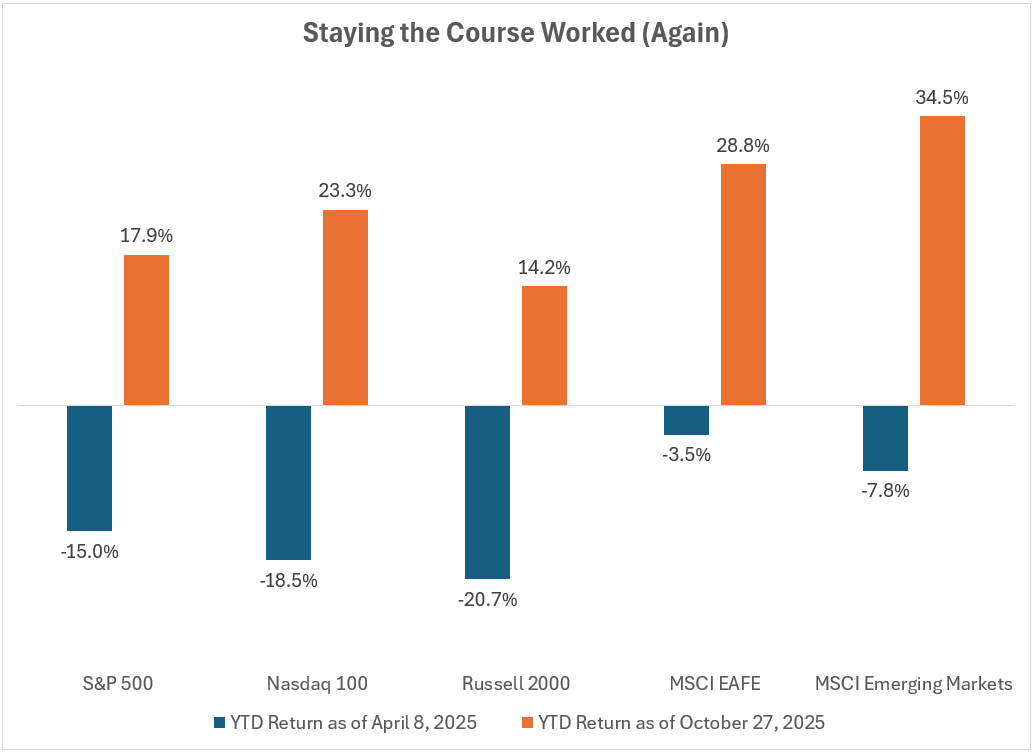Your asset allocation is one of the most important components of building your investment portfolio. In other words, what percentage of your portfolio will you devote to certain assets?
Once you’ve decided on the perfect asset allocation for your 401(k) plan and purchased your investments, you might think your job is done. But that’s not quite the case. Even many passive investing strategies aren’t entirely set-it-and-forget-it.
Instead, you’ll have to occasionally rebalance your portfolio.
Keep reading to learn what rebalancing is, why it’s important to your personal finances, and some of the strategies you can use to rebalance your portfolio.
What is Rebalancing?
Rebalancing is the process of adjusting your portfolio to get back to your original asset allocation. Over time, the investments in your portfolio are likely to perform differently. And while this is to be expected, it also means that eventually, your asset allocation won’t be what you originally intended.
For example, suppose you have a portfolio of 80% stocks and 20% bonds. Your stock investments are likely to outperform the bonds, which means that your stock investments will eventually make up more than 80% of your portfolio.
Rebalancing would mean selling some of your stock holdings and buying more bonds to get back to your original 80/20 mix.
What is Automatic Rebalancing?
When it comes to investing for retirement, plenty of individuals like to take a hands-off approach. In other words, they want to be able to simply make their regular contributions, and have the portfolio do the rest. That’s where automatic rebalancing comes in.
Automatic rebalancing is a feature in a 401(k) account where it automatically adjusts your holdings to get you back to your desired asset allocation.
Automatic rebalancing can happen in a couple of different ways. First, many robo-advisors offer automatic rebalancing as a part of their service.
You set your asset allocation when you set up your account (or they set your asset allocation for you based on your financial goals). And as your portfolio changes, the robo-advisor automatically buys and sells securities as needed to get back to your original asset allocation.
Another way to achieve automatic rebalancing is by investing in target-date funds. A target-date fund is a type of pooled investment like a mutual fund or exchange-traded fund designed to help save for retirement. Companies that offer these types of funds offer them for specific retirement years.
These target-date funds have become one of the most popular funds for people to invest in through their 401(k) plan because they’re easy to understand and require little work on the part of the investor.
Read More: 401(k) Calculator: Are Your Savings on Track?
How Often Should I Rebalance?
There’s no hard and fast rule when it comes to how often you should rebalance your 401(k).
Some experts recommend rebalancing based on a specific timeframe, while others advise waiting until your asset allocation changes by a certain percentage.
Calendar
The calendar method for rebalancing is when you adjust your asset allocation based on a specific schedule, which could be every three, six, or twelve months. If you choose this method, aim to rebalance at least once per year.
The advantage of this method is its simplicity. You can simply set a recurring event on your calendar, so you’re always reminded when it’s time to rebalance. The downside, however, is that rebalancing doesn’t correspond to market shifts.
Sometimes you may go to rebalance and find that there’s been very little change in your portfolio. Other times you may find that your portfolio has changed drastically, and you probably should have rebalanced earlier.
Portfolio
Another method for rebalancing is doing so based on changes in your portfolio. Using this method, you decide on an acceptable level of change in your asset allocation. And once it moves beyond that threshold, you rebalance.
Here’s an example: Let’s say you have a portfolio with 60% stocks and 40% bonds.
You decide you’re comfortable with your stock holdings increasing to no more than 65% of your portfolio. And so, each time your asset allocation reaches 65% stocks and 35% bonds, you rebalance.
The advantage of this method is that you aren’t rebalancing based on a simple timeline, but based on when your portfolio actually needs rebalancing. The downside is that this method requires you to pay closer attention to your portfolio than the calendar method.
CPPI
The most complicated method of deciding when to rebalance your portfolio is the constant proportion portfolio insurance (CPPI) method. Using CPPI, you set a floor on the dollar value of your portfolio.
Then, you use this floor to structure your asset allocation, building a portfolio of risky assets (stocks and mutual funds) and conservative assets (treasury bonds, cash, and equivalents).
The amount of your portfolio that you dedicate to each asset depends on a cushion value (your portfolio’s current value minus your floor number) and a multiplier. You would determine your risky asset allocation by multiplying the cushion by the multiplier. The higher the multiplier, the more of your portfolio you invest in stocks.
Here’s what the CPPI calculation looks like:
Stock Investment = Multiplier x (Portfolio – Floor)
Once your actual asset allocation no longer matches the allocation determined by the CPPI calculation, it’s time to rebalance. This strategy isn’t ideal for more investors because of its complexity.
Instead, the calendar or portfolio methods would suffice.
Types of Rebalancing
Now that we’ve talked about how often you may want to consider rebalancing, we should also discuss how you actually rebalance. There are a couple of different options you can choose here, as well. There’s not necessarily one method that’s better than the other — it all comes down to personal preference.
Buying and Selling
One of the most common strategies to rebalance a portfolio is to simply sell some of the assets that are making up too much of your portfolio and buy more of the other assets. So in an event where your stocks have increased to make up more of your portfolio than you’re comfortable with, you might sell some stocks to buy additional bonds.
Future Contributions
Another strategy to rebalance your portfolio is to, instead of selling some of one asset to buy more of another, you would simply redirect future contributions.
So if your stock investments have grown to take up a disproportionate amount of your portfolio, you would simply use future portfolio contributions to buy additional bonds until your asset allocation is back where you want it.
Rebalancing Example
Now that we’ve talked about how to decide when it’s time to rebalance and some of the strategies you can use to rebalance your portfolio, let’s look at an example.
Let’s say that investor Joe has a portfolio made up of 80% stocks using a total stock market index fund. The other 20% of Joe’s portfolio is in a total bond market index fund. Joe has a total of $100,000 in his investment portfolio.
Joe has decided he’s going to use the calendar method of rebalancing, so he has a recurring event on his calendar to rebalance every year. When he sits down to rebalance his portfolio, he finds that the stock market has done quite well over the past six months.
His portfolio is now worth $125,000, with $102,500 of it — or about 82% — in stocks.
To rebalance his portfolio, Joe decides to sell some of his stocks to get back to his 80/20 asset allocation. To achieve that, he would have to sell $2,500 of stock to buy additional bonds.
For the purposes of the examples in this article, we’ve solely looked at the balance between stocks and bonds. But remember, that’s not the only mix you’re likely to have in your portfolio. You may have some of your stock investments in small-cap, mid-cap, and large-cap stocks.
Just as you want to make sure stocks, in general, don’t make up a disproportionate percentage of your portfolio, you want to ensure each type of holding in your portfolio is at your desired percentage.
It’s also important to note that while rebalancing often involves reducing your stock holdings to increase your bond holdings, that’s not always the case. In the midst of a recession or after a market correction, you might find yourself selling bonds to purchase additional stocks. And while it can be scary to buy stocks when the market is low, look at it this way — you’re buying stocks when the entire market is on sale.
Read More: The Average 401(k) Balance By Age
Benefits of Rebalancing
The key benefit of rebalancing your portfolio is to keep your asset allocation where you originally intended it to be. Remember, you chose your asset allocation for a reason — likely to manage risk and build a portfolio that aligns with your financial goals, time horizon, and risk tolerance.
As assets within your portfolio grow, your asset allocation will change.
Rebalancing allows you to maintain the investment mix that you’ve decided best aligns with your financial goals.
It’s important to note that rebalancing can sometimes feel counterintuitive. After all, you’re often selling investments that are performing really well to buy investments that are falling behind. And it’s true that it can feel like a strange choice, when an investment is performing really well is actually the best time to sell it. You lock in the gains on that security rather than potentially waiting for its value to drop.
Additionally, while the stock market performs really well sometimes, it also goes through corrections.
And when that happens, you’ll be glad to have lower-risk investments in your portfolio.
Rebalancing a Taxable Brokerage Account
In this article, we’re specifically addressing rebalancing in a 401(k) plan. The advice we’re sharing could also apply to another tax-advantaged account like an individual retirement account. But if you need to rebalance a portfolio in a taxable brokerage account, there’s a bit more that goes into it.
In tax-advantaged retirement accounts, your investments grow either tax-free or tax-deferred. And you don’t have to pay capital gains taxes when you sell an asset for more than you bought it.
But in a taxable brokerage account, you’ll be on the hook for capital gains taxes when you make a profit on an asset. Because of that, rebalancing in that type of account requires a bit more care.
Read More: When Can You Withdraw From Your 401(k) or IRA Penalty Free?
Key Takeaways
Rebalancing is an important step in managing your investment risk and ensuring that your asset allocation remains where you intended it to be. And as we discussed earlier, rebalancing doesn’t always have to be a hands-on task for you as the investor.
When you work with Personal Capital’s wealth management team, your portfolio will go through ongoing rebalancing to help take advantage of market opportunities, avoid emotional decisions, and maintain a well-diversified portfolio.
Read More: 401(k) Management Program Now Available to Personal Capital Clients
Get Started with Personal Capital
Author is not a client of Personal Capital Advisors Corporation and is compensated for the content contained in this article.
The content contained in this blog post is intended for general informational purposes only and is not meant to constitute legal, tax, accounting or investment advice. Compensation not to exceed $500.
You should consult a qualified legal or tax professional regarding your specific situation. Keep in mind that investing involves risk. The value of your investment will fluctuate over time and you may gain or lose money. Any reference to the advisory services refers to Personal Capital Advisors Corporation, a subsidiary of Personal Capital.
Personal Capital Advisors Corporation is an investment adviser registered with the Securities and Exchange Commission (SEC). Registration does not imply a certain level of skill or training nor does it imply endorsement by the SEC.
Original Article






